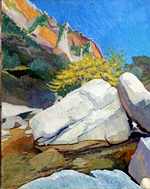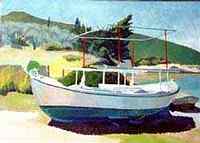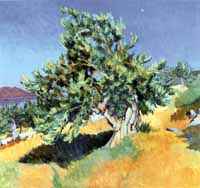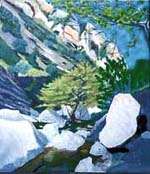|
When British painter David Shutt came to Greece in 2001 he was looking for a quality of light and a context for philosophical ideas which have their origins here, in the hope of making a unified image which celebrated both. It turned out that his stay, a five and a half month sabbatical from teaching at Canterbury's Christ Church University College, was one of the artist's most prolific periods. The paintings he made were shown in the artist's first one man show in Greece at the Jill Yakas Gallery in April 2002. Shutt is a dedicated landscape painter, having spent twenty years painting the mountainous region of Snowdonia in North Wales. His 'Greek paintings' have grown out of the same interest, but are distinct in terms of light. They also speak of an artist who influenced by the country's ancient past, searches for his own personal Arcadia in the surrounding nature. Distantly evocative of the work of 19th-century travelling painters, Shutt's paintings have a romantic and most appealing feel to them. The two artists who have influenced David Shutt most in a direct way, are the English painters Patrick Symons and Euan Uglow. They made Shutt aware, amongst other things, of the work of Jay Hambidge who published two books in the early 20th century: 'The Greek Vase' and 'The Elements of Dynamic Symmetry'. He had been a keeper of the substantial collection of Greek ceramics in Boston Museum and had recognized the superior beauty and harmony of the pieces in the collection of the classical period of the age of Pericles, over the less integrated works which preceded and followed them. He started measuring them and discovered those works to possess very particular qualities of proportion which are mathematically associated with Pythagorean ideas, which have come down to us in Plato's 'Timaeus'. They are especially present in the 'divine' platonic solid, the dodecahedron, as opposed to those associated with the four elements and Plato's atomic theory: the cube, the tetrahedron, the octahedron and the icosahedron. The dodecahedron possesses the ratio of the golden section since it is composed of pentagonal facets whose chords intersect each other in that ratio and this is the basis of the cosmos, to be found throughout nature in philotaxis (the organizing principal of plants), animal growth and musical structure, in the Pythagorean world view. It is a very appealing poetic and pantheistic idea. For many years Shutt has been interested in ideas of figure composition and pastoral landscape which also have their origins here in Greece. The idea of the self-confident, self aware and integrated nude has its origins in Greek sculpture and the most appealing context for the nude is Arcadia, celebrated in the paintings of Titian, Claude, Poussin, Cezanne and Matisse. For twenty years Shutt has painted the upland region of Snowdonia, a sheep rearing landscape of North Wales, and having developed a deep devotion to a particular locality since childhood, had come to think of it as a personal arcadia, which has many shared characteristics in common with the geographic Arcadia in Greece. Because many of Cezanne's figure compositions are based on the story of Diana (Artemis) and Callisto as told by Ovid in his 'Metamorphosis' Shutt started painting a number of compositions loosely based on those events. To research the quality of light appropriate to the story, set in Arcadia,he has been painting in a number of Mediterranean locations in France (near Cezanne's Mte. S. Victoire for example), Italy, Spain, Portugal, Malta, and now more substantially, in Greece. Shutt spent the Spring and Summer of 2001 painting the marvelous landscape around the archaeological site of Troezen, associated with Orestes, Theseus, Hippolytus and Phaedra. The changing cycle of the seasons and the way the vegetation, environment and light changed, became the subjects of his studies, ultimately to inform the most recent 'Artemis and Callisto' composition (still in progress). So this may explain why 'Sea, Olive, Moon' is composed in a pentagon, 'Looking Up and Down the Gorge' is in a golden section and 'The Painter's First Shed' is in the square root of a golden section, and 'Phaedra' is in three squares. The internal dynamics of these shapes have given their coherence to the subjects. From the subject, in each case, the shape of the canvas becomes the outward manifestation of the space it occupies and the glow of colour and light which infuse this marvelous place. David Shutt, born in Cheshire, England, graduated with a B.A. First Class Hons in Fine Art from Leeds University, and a Higher Diploma in Painting (Postgraduate ) from the Slade School in London.
|





|
Email jillyakas@gmail.com
All images contained in these pages © Respective Artists
ALL RIGHTS RESERVED